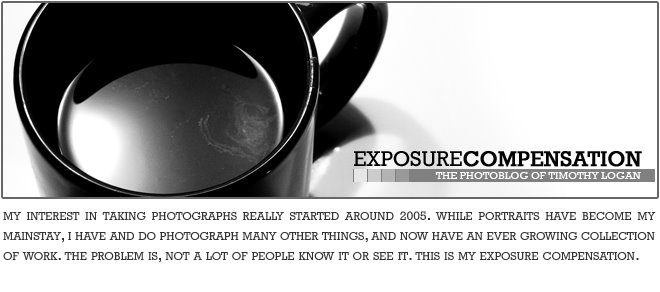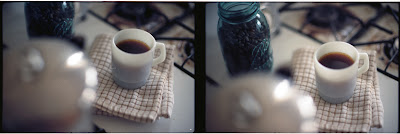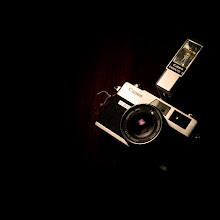25 February 2013
Expired Polaroid ID Ultraviolet Film - Polaroid Land 250 - Hillary
I realize that recently I haven't been posting a lot of instant photos - something that I used to do pretty regularly. One of the big reasons behind that is simply that I've haven't been shooting as much instant film recently as I've been so focused on shooting my film for my Roll-A-Week project. I know that in order to get through my roll each week I must dedicate a good deal of my shooting to using the roll of film for that week, otherwise, I will get distracted, start shooting with 4 different cameras, 6 different films and my phone. To that end, I've really limited the number of cameras and film types that I've been carrying with me when I go out to shoot.
Shooting instant film though, is one of my favorite photographic formats and something that I don't plant to stop doing anytime soon. While I may not be shooting quite as much of it this year, I will definitely be making a conscious effort to continue to use it regularly enough that I have a few extra photos to share here on the the blog.
Today's photo is from a shoot I did this past weekend with Hillary, a model from Cleveland's Taxi MGMT. This is actually the only instant photo that I took through the entire session, but, I think it came out pretty well. The film is expired Polaroid ID UV and it was shot using a Polaroid Land 250. More images from this set, shot on 35mm Ilford 3200, will be coming soon over on the Coalesce52 Blog as part of my Week 9 post.
Enjoy.
13 February 2013
Fuji FP-3000B45 - Graflex Crown Graphic 4x5 - Portraits With Ciarra
If you'd like to see more of my work with Ciarra (this look and others) keep an eye out over on the Coalesce52 blog for my Week 6 images - A roll of Kodak Tri-x that I shot throughout this shoot with Ciarra. Those images should be posted sometime in the next day or two.
Labels:
4x5,
Analog Photography,
Black and white,
cleveland ohio,
Crown Graphic,
Film,
Fuji FP 3000B45,
Instant film,
Large format,
model,
photography,
press camera
Location:
Cleveland, OH, USA
12 February 2013
Fuji FP-3000B45 - Graflex Crown Graphic 4x5 - Fashion With Ciarra
As I mentioned yesterday, I recently had the opportunity to shoot with a model that I've not yet had the chance to work with. Ciarra, a model local to Cleveland, has quite an impressive portfolio of images. If that's not enough, she was also kind enough to bring along an amazing makeup artist to work with us as well - Jason Kelly.
Today's image is one of three that I shot using my Graflex Crown Graphic 4x5 Press camera with Fuji FP3000B45 film. I do plan to post the other two images (from a different look we shot) in the near future, but, I liked the look and feel of this image so much that I thought it deserved to stand alone.
Keep your eye out for more images from this and other recent shoots including a couple rolls of film that I'll be receiving back this afternoon.
Enjoy.
Labels:
Analog Photography,
Black and white,
Crown Graphic,
Fashion,
Film,
Fuji FP 3000B45,
Graflex,
Instant film,
Large format,
makeup,
model,
photography,
Polaroid
Location:
Cleveland, OH, USA
11 February 2013
Fuji FP-3000B45 - Graflex Crown Graphic 4x5 - Tiffany
This past weekend was filled with photography and film. Saturday I shot with a new model in the studio and wrapped up my roll of film for Week 6 of the Coalesce 52 project. Then, Sunday afternoon, I shot two rolls of film with artist/illustrator Branden Vondrak in his home studio (which just so happened to wrap up my Week 7 for the Roll-A-Week project). And finally, in between those shoots, I took these photos with my lovely girlfriend at home. I'll be sharing all kind of images from those other shoots as well, but, seeing as how this is the first times Tiffany has ever let me sit her down and take a formal photo of her I thought I'd post these first.
Both of these images are from one of my final four remaining packs of the large format instant film Fuji produced - Fuji FP3000B45 - and both were taken with my Graflex Crown Graphic 4x5 press camera. I recently decided that instead of clutching on to this film and holding on to it forever that I should get it out of the fridge and put it to good use while it's still in it's prime. When I end up with photo's like this it makes me think that I made a pretty good decision.
Enjoy.
Labels:
Analog Photography,
Black and white,
Crown Graphic,
Film,
fuji,
Fuji FP 3000B45,
Graflex,
Instant film,
Large format,
photography,
portrait,
press camera
Location:
Cleveland, OH, USA
08 February 2013
Kodak Ektar 100 - Canon FTb - A Little On Process
This past week I shot a roll of Kodak Ektar 100 color negative film using my Canon FTb with a 55mm f/1.2 lens for my year long Roll-A-Week project - Coalesce52. After getting the film developed I started to go through the slow process of scanning and organizing my negatives and was reminded of a video that I had watched a few months back over on FStoppers. Photographer Scott Kelby, during the Google + conference in San Fransico, spoke to a live audience about how to work your scene to find the best composition. He even went as far as to take you through his RAW images to show you his own personal process and how even a professional photographer can shoot many images before arriving at the final image. It's an interesting video and if you have time to watch it I definitely think it's worth checking out (I personally love listening to photographers of all genres and backgrounds as I think you can learn something from everyone).
Of course, this concept of high volume shooting to perfect your composition is much easier when you are shooting digital. Now a days, you can essentially take an infinite number of shots (that's only a little exaggerated) and have the ability to immediately see on the back of your camera what your results are. So, what if you're not shooting digital? Well, I was surprised to find that I actually do this a bit when I'm shooting film - more with 35mm, less with medium format, and, almost not at all with large format and instant films (unless the shot is very important to me for one reason or another... then I might give the subject two exposures).
With that in mind, here's a look at my miniaturized process for two of the setups that I shot with this roll of film. My first final image is one that I featured over on the Coalesce52 blog and you can also see that image at top. Here, seen below, are the three images that I took right before I ended up with this shot (click for full view):
You'll notice, not a lot of change. These images, though, are very different in my opinion. My position moved, my distance from the subject changed and my rotation relative to the subject changed. Now, keep in mind that I wasn't thinking of the aforementioned video or process when I was shooting these images. I was simply going about my standard shoot process knowing that I wanted to get the best shot possible and that I only wanted to shoot 4-5 images on this setup. Had I stopped after the first exposure, I would have ended up with a decent image, but just three images later (I feel) I ended up with a much stronger composition.
Below you can see another example of my process, this time a bit more dramatic, as I worked my way through another setup. The first two images were pretty awful:
And I kind of felt that after I made these exposures, so, I rotated my position a bit to end up with my next two exposures - which were better, but not quite there yet.
And that's when my composition completely changed - I rotated even more to square myself to the subject, I raised the perspective and switched to a vertical orientation. Of course, as with most things, it's all a matter of opinion which of your images you like best, but I believe that my final image (below) is a much cleaner, stronger composition than the above four images that led me to it.
Now, I do undertand that what Scott Kelby is discussing and what I am showing here are essentially two different things. Shooting film though, is a very different thing than shooting digital. One of the key differences with my process (besides the limited number of exposures I'm shooting per subject) is that I can't see my images after shooting them to check for exposure and composition. I can't compare one image to the next. And that, is where pre-visualiztion and expected outcome becomes so important.
Knowing that I was shooting a 36-exposure roll of film I was comfortable leading myself through this process of experimentation and making extra exposures throughout the course of this shoot. Of course, I didn't know that I was doing it and didn't realize it until I saw my negatives lined up - okay shot, adjust, okay shot, adjust, okay shot, adjust... Good image. Then, when I started to think about it, I realized that I actually go through a similar process when I'm shooting medium format, large format and instant film with one key difference - I don't actually fire the shutter. I set up my image and view it through the camera, I move and do it again, and again, and then back, and again... but eventually I end up with the final Image I'm looking for.
I'm not saying that my process is the correct one, but Scott's video and my most recent negatives made me consider my process and how it changes with the format I'm shooting. Personally, I think that's all that improving your process takes sometimes... something that catches your attention and makes you examine the way you go about things. I might not change significantly moving forward, but, with my next roll of film I will pre-visualize and think a second longer before I fire the shutter each time. That's what I love about shooting film though... it makes me stop, it makes me think and it helps me improve my approach to nearly everything, not just photography.
If you stuck with me this far, thank you, and if you'd like to see more from this roll of film please visit my Week 5 post on the Coalese52 blog. If you have any thoughts on process or want to share your own I'm alway happy to get a few comments.
Enjoy.
Labels:
35mm,
analog,
Analog Photography,
believeinfilm,
Canon FTb,
cleveland,
Color,
composition,
ektar 100,
Film,
kodak,
process,
scott kelby
Location:
Cleveland, OH, USA
Subscribe to:
Comments (Atom)















